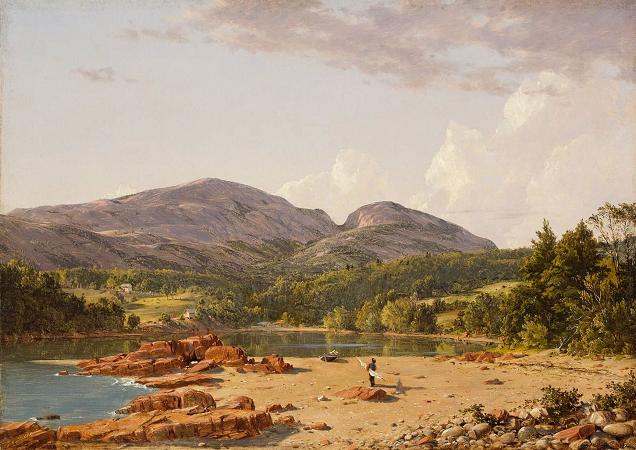Mount Desert Island. Mount Desert Island in Hancock County, Maine, is the largest island off the coast of Maine. With an area of 108 square miles it is the 52nd-largest island in the United States, the sixth-largest island in the contiguous United States, and the second-largest island on the Eastern seaboard, behind Long Island and ahead of Martha's Vineyard. According to the 2010 census, the island has a year-round population of 10,615. In 2017, an estimated 3.5 million tourists visited Acadia National Park on MDI. The island is home to numerous well known summer colonies such as Northeast Harbor and Bar Harbor. Some residents stress the second syllable in the French fashion, while others pronounce it like the English common noun desert. French explorer Samuel de Champlain's observation that the summits of the island's mountains were free of vegetation as seen from the sea led him to call the island L'Isle des Monts-déserts. There are four towns on Mount Desert Island: Bar Harbor, with the villages of Eden, Hulls Cove, Salisbury Cove, and Town Hill;. Mount Desert, with the villages of Hall's Quarry, Northeast Harbor, Otter Creek, Pretty Marsh, Seal Harbor, and Somesville; Southwest Harbor, with the villages of Manset and Seawall; Tremont, with the villages of Bass Harbor, Bernard, Gotts Island, Seal Cove, and West Tremont. Deep shell heaps indicate American Indian encampments dating back 6,000 years in Acadia National Park, but prehistoric data is scanty. The first written descriptions of Maine coast Indians, recorded 100 years after European trade contacts began, describe American Indians who lived off the land by hunting, fishing, collecting shellfish, and gathering plants and berries. The Wabanaki Indians knew Mount Desert Island as Pemetic, the sloping land. They built bark-covered conical shelters, and traveled in exquisitely designed birch bark canoes. Historical notes record that the Wabanaki wintered in interior forests and spent their summers near the coast. Archeological evidence suggests the opposite pattern; in order to avoid harsh inland winters and to take advantage of salmon runs upstream, American Indians wintered on the coast and summered inland. The first meeting between the people of Pemetic and the Europeans is a matter of conjecture, but it was a Frenchman, Samuel de Champlain, who made the first important contribution to the historical record of Mount Desert Island. Champlain led an expedition from the St. Croix Settlement. He was tasked with exploring the coast in a patache with twelve sailors and two American Indian guides. They were in search of a mythical walled and wealthy American Indian city named Norumbega. On September 6, 1604 the expedition crossed Frenchman Bay and sailed towards Otter Creek, where smoke could be seen rising from an American Indian encampment. During high tide the ship hit a ledge off Otter Cliff and while repairing a hole two American Indians boarded the ship as guides. It is not clear whether Champlain sailed around the Island or was informed by the guides, but on that day, he wrote in his journal, Le sommet de la plus part d'icelles est desgarny d'arbres parceque ce ne sont que roches. Je l'ay nommée l'Isle des Monts-déserts, which translates to The mountain summits are all bare and rocky. I name it Isles des Monts Desert. In 1613, French Jesuits, welcomed by Indians, established the first French mission in America, Saint Sauveur Mission, on what is now Fernald Point, near the entrance to Somes Sound. Saint Sauveur Mountain, overlooking the point, still bears the name of the mission. The French missionaries began to build a fort, plant their corn, and baptize the natives. Two months later, on July 2, 1613, Captain Samuel Argall of the Colony of Virginia arrived on board the Treasurer and destroyed their mission. Three of the missionaries were killed and three were wounded. The rest of the company, some twenty in all, were taken prisoner. Argall took many of the prisoners to Jamestown. He eventually returned to Saint-Sauveur and cut down the cross the Jesuits had planted, replacing it with a Protestant version. He then set fire to the few buildings that were there. He then went on to burn the remaining French buildings on Saint Croix Island and Port Royal, Nova Scotia. The English raid at Fernald Point signaled the dispute over the boundary between the French colony of Acadia to the north and the English colony of New England to the south. There is evidence that Claude de La Tour immediately challenged the English action by re-establishing a fur-trading post in the nearby village of Castine in the wake of Argall's raid.
more...











